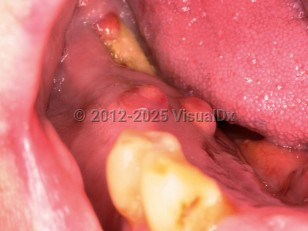Bisphosphonate-related osteonecrosis of the jaw - Oral Mucosal Lesion
Alerts and Notices
Important News & Links
Synopsis

Approximately one-half to two-thirds of lesions are painful. The first complaint may be pain not at the site of exposed bone, but rather on the tongue because of trauma from sharp edges of the bone on the lingual mandible causing ulceration of the tongue ventrum.
BONJ is most commonly seen in patients using high doses of intravenous bisphosphonates for oncology purposes; the risk is directly related to cumulative dose. Bisphosphonates are powerful osteoclast inhibitors and therefore suppress bone turnover. A possible theory of pathogenesis suggests that when there is an increased need for bone turnover, such as in surgery to the jaws, and the jawbone is unable to meet this requirement, the bone becomes necrotic. Most recently, local infection by oral bacteria has been shown to play an important role. It is likely that lesions result from both mechanisms. Anti-angiogenesis also plays a role but it is unclear to what extent.
Oral preparations (such as alendronate) have been used for more than a decade for the prevention of fractures in patients with osteoporosis. The more powerful and better absorbed intravenous bisphosphonates (such as zoledronic acid and pamidronate) are used to reduce skeletal-related events related to bone malignancies such as multiple myeloma and metastatic tumors to the bone (especially metastatic breast and prostate cancer). Secondary actions of bisphosphonates such as anti-angiogenic and tumoricidal activity as well as activation of the immune system may also play a role in control of such skeletal-related events.
Predisposing factors include tooth extraction or other form of dento-alveolar surgery, intravenous preparations used in oncology treatment doses, and odontogenic infection. Other comorbidities may include diabetes and smoking.
A common presentation is a history of a dental extraction (present in 60% of cases) with poor healing or non-healing of the extraction socket so that months later, there is exposed bone within the socket or in the surrounding jawbone. This usually persists for months and years with spontaneous exfoliation of pieces of bone over time. Teeth associated with BONJ may also spontaneously exfoliate.
Codes
M87.180 – Osteonecrosis due to drugs, jaw
SNOMEDCT:
293295008 – Adverse reaction caused by bisphosphonate
Look For
Subscription Required
Diagnostic Pearls
Subscription Required
Differential Diagnosis & Pitfalls

Subscription Required
Best Tests
Subscription Required
Management Pearls
Subscription Required
Therapy
Subscription Required
Drug Reaction Data
Subscription Required
References
Subscription Required

